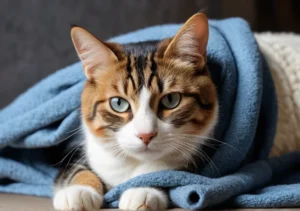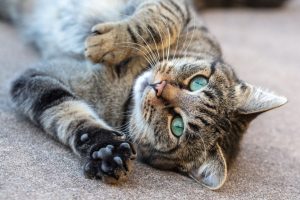Cats are known for their curious and sometimes quirky behavior. One common behavior that many cat owners have likely observed is their cats clawing at blankets. But why do they do this? Let’s explore the reasons behind this fascinating feline behavior.
Cats claw at blankets for various reasons, including instinctual behavior, comfort-seeking, and territorial marking. Understanding why your cat engages in this behavior can help you better understand your furry friend and provide appropriate enrichment and care. Below is an outline to help break down the reasons behind why cats claw at blankets.
Instinctual Behavior
Cats clawing at blankets may seem like a random behavior, but it actually stems from their instinctual nature. In the wild, cats use their claws for a variety of purposes, including hunting, marking territory, and self-defense. When your furry feline friend kneads or claws at your cozy blanket, they are simply acting on their natural instincts.
Additionally, clawing at blankets serves as a way for cats to exercise their claws and keep them sharp. This behavior helps them maintain their claws for various tasks, such as climbing trees or defending themselves against predators. So, the next time you catch your kitty in the act, remember that it’s just their wild instincts at play.
Comfort-Seeking
Beyond their instinctual drive, cats also claw at blankets as a means of seeking comfort and security. When a cat kneads or claws at a soft blanket, it’s reminiscent of the behavior they exhibited as kittens, kneading their mother’s belly to stimulate milk flow. This comforting action releases endorphins, making your kitty feel safe and content.
Moreover, clawing at blankets can be a form of self-soothing for cats, especially in stressful situations. By kneading or clawing at a cozy blanket, your feline friend can relax and alleviate anxiety. So, the next time your cat curls up on your bed and starts kneading your blanket, know that they are simply seeking solace and comfort in their own unique way.
Additional Insight:
- Providing your cat with a designated scratching post can help redirect their clawing behavior away from your blankets. Encourage your cat to use the scratching post by enticing them with toys or treats, ultimately preserving the integrity of your favorite blanket.
Territorial Marking
Cats claw at blankets as a way to assert their ownership and mark their territory. By scratching at the fabric, they leave behind scent markers from glands in their paws, signaling to other animals that this is their space. This behavior is instinctual and helps cats feel secure in their environment. If your cat is constantly clawing at blankets, provide them with appropriate scratching posts to redirect this natural behavior.
Communication
When your cat claws at blankets, they may be trying to communicate with you. This action can signal various messages, such as seeking attention, showing affection, or expressing discomfort. Pay attention to your cat’s body language and vocalizations to understand what they are trying to convey. If your cat is clawing at blankets excessively, it could be a sign of stress or anxiety. Providing them with a comfortable and safe environment can help alleviate these issues.
Additional Unique Insight: Cats may also claw at blankets as a way to create a cozy nesting spot. By kneading and scratching at the fabric, they are creating a comfortable space to rest and relax. If your cat does this before settling down for a nap, it’s a sign that they feel comfortable and safe in your home.
Remember, cats communicate in subtle ways, so pay attention to their behavior to understand their needs and feelings. By providing them with a conducive environment and plenty of mental and physical stimulation, you can help prevent unwanted scratching behavior.
Stress Relief
Cats claw at blankets as a form of stress relief. Similar to how humans fidget or bite their nails when they’re feeling anxious, cats may knead or scratch at blankets to calm themselves down. This behavior helps them release pent-up energy and tension, making them feel more relaxed and secure. If your cat is constantly clawing at blankets, it might be a sign that they are experiencing some form of stress or uncertainty. Providing them with a cozy blanket or a warm, comfortable spot to relax can help alleviate their anxiety and reduce their need to claw at things.
Environmental Enrichment
To prevent your cat from constantly clawing at blankets, it’s essential to provide them with alternative outlets for their behavior. Investing in a sturdy scratching post or pad can help fulfill your cat’s natural instinct to scratch and stretch their muscles. Additionally, incorporating interactive toys and puzzle feeders into their environment can promote mental stimulation and physical activity, reducing their urge to claw at things out of boredom. Remember, a happy and mentally stimulated cat is less likely to engage in destructive behaviors like excessive clawing.
- Vertical Space: Cats love to climb and perch on high vantage points. Consider installing cat shelves or a multi-level cat tree to give your feline friend some vertical space to explore and scratch.
- Hide and Seek: Encourage your cat’s natural hunting instincts by hiding treats or toys around the house for them to find. This not only provides mental stimulation but also keeps them engaged and entertained.
- Rotating Toys: Keep your cat’s toys fresh and exciting by rotating them regularly. Introducing new toys or rotating their old favorites can prevent boredom and reduce their desire to claw at blankets or furniture.
- Outdoor Access: If possible, allow your cat access to a safe outdoor space, such as a catio or enclosed patio. Fresh air and the opportunity to explore the outdoors can greatly enrich your cat’s life and reduce their need to claw at indoor items.
Remember, understanding why your cat claws at blankets is the first step in addressing this behavior effectively. By providing them with a stimulating environment and addressing their stress or anxiety, you can help your cat lead a happier, more fulfilling life.
Training Techniques
If your cat has taken a liking to clawing at your blankets, fear not – there are ways to steer their behavior in a more appropriate direction. Redirecting your furry friend towards a scratching post can help satisfy their natural urge to claw while also protecting your bedding. To encourage this behavior, place the scratching post in a prominent and enticing location, such as near their favorite napping spot. You can also entice them by sprinkling some catnip on the post or using a wand toy to guide their attention. Don’t forget to reward them with treats or praise when they use the scratching post, reinforcing positive behavior.
Health Considerations
While a little bit of clawing is normal for cats, excessive scratching at blankets could be a sign of underlying health issues. If you notice your cat obsessively clawing at blankets or furniture, it’s essential to consult with a veterinarian. This behavior could be a result of stress, anxiety, or even a medical condition like skin allergies or parasites. Your vet can help identify the root cause of the behavior and provide appropriate treatment options to keep your cat happy and healthy.
List of Health Considerations
- Skin Allergies: Cats with sensitive skin may scratch excessively due to allergies to certain materials in blankets.
- Parasites: Fleas or mites can cause itching and discomfort, leading to increased clawing behavior.
- Stress or Anxiety: Cats may claw at blankets as a coping mechanism for stress or anxiety in their environment.
- Physical Pain: Underlying health issues such as arthritis or injuries could also contribute to increased clawing behavior.
Remember, understanding the reasons behind your cat’s clawing behavior is the first step towards addressing it effectively. By providing them with appropriate outlets for their scratching instincts and monitoring their health closely, you can ensure a happy and harmonious relationship with your beloved feline friend.
Fun Facts
Cats have a natural instinct to claw at blankets due to their need to knead. This behavior is often seen in kittens when nursing, where they knead their mother’s belly to stimulate milk flow. As cats grow older, they continue this behavior as a way to comfort themselves and mark their territory with scent glands in their paws. So, when your feline friend is clawing at your blankets, they might just be trying to create a cozy spot for themselves or simply showing their affection.
Additional Insight:
– Providing your cat with a designated scratching post can help redirect their clawing behavior away from blankets. Make sure to reward them with treats or praise when they use the scratching post to reinforce positive behavior.
By understanding these fun facts about why cats claw at blankets, you can better appreciate your furry friend’s natural instincts and strengthen your bond with them. So next time you catch your cat kneading away at your favorite throw, remember it’s just their way of feeling at home and expressing their love for you.
Alex, a passionate animal lover, has experience in training and understanding animal behavior. As a proud pet parent to two dogs and three cats, he founded AnimalReport.net to share insights from animal experts and expand his knowledge of the animal kingdom.




